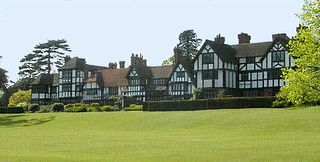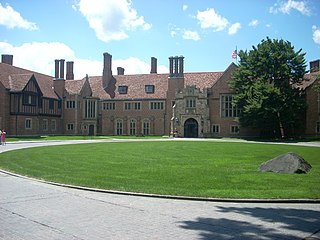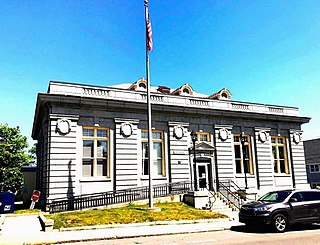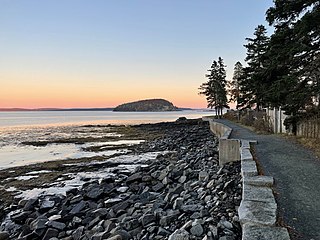Bar Harbor is a resort town on Mount Desert Island in Hancock County, Maine, United States. As of the 2020 census, its population is 5,089. During the summer and fall seasons, it is a popular tourist destination and, until a catastrophic fire in 1947, the town was a noted summer colony for the wealthy.

Tudor Revival architecture first manifested itself in domestic architecture in the United Kingdom in the latter half of the 19th century. Based on revival of aspects that were perceived as Tudor architecture, in reality it usually took the style of English vernacular architecture of the Middle Ages that had survived into the Tudor period. The style later became an influence elsewhere, especially the British colonies. For example, in New Zealand, the architect Francis Petre adapted the style for the local climate. In Singapore, then a British colony, architects such as R. A. J. Bidwell pioneered what became known as the Black and White House. The earliest examples of the style originate with the works of such eminent architects as Norman Shaw and George Devey, in what at the time was considered Neo-Tudor design.

Meadow Brook Hall is a Tudor revival style mansion located at 350 Estate Drive in Rochester Hills, Michigan. It was built between 1926 and 1929 by the heiress to the Dodge automaker fortune, Matilda Dodge Wilson and her second husband, lumber baron, Alfred Wilson. Covering 88,000 square feet (8,200 m2) with 110 rooms, the structure is the fourth largest historic mansion museum in the United States, and is classified as one of America's Castles. In 1957, the mansion and the surrounding property and buildings were donated to the state of Michigan in order to fund Michigan State University–Oakland, now known as Oakland University. The structure was named a National Historic Landmark in 2012.
The Church of Our Father is a historic Episcopal church in Hulls Cove, a village of Bar Harbor, Maine. Built in 1890-91 to a design by William Masters Carmac, it is an excellent local interpretation of English Gothic Revival architecture executed in stone. It was part of a period trend in the construction of architect-designed summer chapels in coastal Maine. The building was listed on the National Register of Historic Places in 1999.
The Harbor Lane–Eden Street Historic District encompasses a neighborhood of Bar Harbor, Maine, consisting of architect-designed summer estates that served as the summer of elite society families of the late 19th and early 20th centuries. Located northwest of the main village and fronting on Frenchman Bay, the district includes nine summer houses that survived a devastating 1947 fire which destroyed many other summer estates. The district was listed on the National Register of Historic Places in 2009.
Cleftstone is a historic summer house at 92 Eden Street in Bar Harbor, Maine. Built in 1881 and enlarged in 1894, it is an architecturally eclectic combination of elements from the Shingle, Queen Anne, and Colonial Revival styles. It is now Cleftstone Manor, a hotel with seventeen guest rooms. It was listed on the National Register of Historic Places in 1999.

Eegonos, known more recently as East of Eden, is a historic summer estate house at 145 Eden Street in Bar Harbor, Maine. Built in 1910 to a design by Boston architect Guy Lowell, it is one of a small number of summer houses to escape Bar Harbor's devastating 1947 fire, which resulted in the destruction of many such buildings. It is an architecturally sophisticated expression of Beaux Arts and Mediterranean Revival styles, and was listed on the National Register of Historic Places in 1980.
The Farm House is a historic summer estate at 15 Highbrook Road in Bar Harbor, Maine. The estate includes a 19th-century farmhouse which was extensively altered in the 1920s to Colonial Revival designs by Arthur McFarland, who also designed a caretaker's cottage on the property. The property also includes a series of garden spaces designed by Beatrix Farrand. This work was done for Mildred McCormick, an heir to the fortune of Cyrus McCormick, inventor of the combine harvester. The estate was listed on the National Register of Historic Places in 2007.
Nannau is a historic summer estate house in Bar Harbor, Maine. Located between Maine State Route 3 and overlooking Compass Harbor, this 1904 Shingle style house was built for David R. Ogden, a New York City lawyer, to designs by the Boston firm Andrews, Jaques and Rantoul. The house was characterized in 1906 as "an excellent example of shingle work"; it was listed on the National Register of Historic Places in 1984.
The John Peters House is a historic house, and the centerpiece of the John Peters Estate on Peters Point in Blue Hill, Maine. Built in 1815 and enlarged c. 1900 and 1920, the property is historically significant for its association with John Peters, one of the first proprietors of Blue Hill, who arrived in the region in 1765, and was a prominent figure in local political and economic life for many years. His house was listed on the National Register of Historic Places in 1983; after serving for a time in the 20th century as an inn, it is now available for rent as an event venue.
Raventhorp is a historic summerhouse in Southwest Harbor, Maine. It is prominently situated at the northern tip of Greening Island, which is set at the mouth of Somes Sound, the inlet dividing Mount Desert Island, between the villages of Southwest Harbor and Northeast Harbor. It was designed by the partnership of Fred L. Savage and Milton W. Stratton and built in 1895 for Joseph Gilbert Thorp and Anne Longfellow Thorp. The Shingle style house is an important surviving example of this collaboration, and was listed on the National Register of Historic Places in 1988.

Reverie Cove is a historic summer estate on Harbor Lane in Bar Harbor, Maine. It was designed by local architect Fred L. Savage and built in 1895, and is a particularly opulent example of Colonial Revival architecture. A later owner of the property was New York City mayor Abram Hewitt. The house was listed on the National Register of Historic Places in 1982, and as part of the Harbor Lane-Eden Street Historic District in 2009.

The U.S. Post Office-Bar Harbor Main is a historic post office building at 55 Cottage Street in Bar Harbor, Maine. This handsome granite Classical Revival building was one of twelve post offices built in 1909, and is reflective of the government's trend at that time to use classical architecture as a way to express democratic ideals and institutions. The building was listed on the National Register of Historic Places in 1986.

The West Gouldsboro Village Library is a historic former library building in Gouldsboro, Maine. Located in West Gouldsboro, this building, designed by Fred L. Savage and built in 1907, is one of the only libraries in Maine built in the Tudor Revival style. It served as a library from 1907 to 1956, and again for a period beginning in 1990. The town's library services are currently provided by the Dorcas Library in Prospect Harbor. This building was listed on the National Register of Historic Places in 1991.

The West Street Historic District is a residential historic district just adjacent to the main village of Bar Harbor, Maine. Extending from Eden Street to Billings Avenue, it encompasses a well-preserved concentration of summer "cottages" built during Bar Harbor's heyday as a resort for the wealthy in the early 20th century. The district was listed on the National Register of Historic Places in 1980.
The Philler Cottage, previously the Dark Harbor House Inn, is a historic house at Pendleton Point and Jetty Roads in Islesboro, Maine. Built in 1894 for a wealthy Philadelphia banker, it is a high-quality regional example of a Georgian Revival summer house. It was listed on the National Register of Historic Places in 1985.

33 Ledgelawn Avenue is an historic building in Bar Harbor, Maine, formerly St. Edward's Convent. It is an architecturally distinguished building designed by local architect Milton Stratton and built in 1917 in the Jacobethan style. The building was listed on the National Register of Historic Places in 1998. It was home to the Bar Harbor Historical Society until early 2019.

Frederick Lincoln Savage was an American architect, known as Mount Desert Island's most prolific native architect. During the late 19th and early 20th centuries, he designed over 300 cottages on the island and across Northeastern Maine, including Reverie Cove and the John Innes Kane Cottage in Bar Harbor, and Raventhorp in Southwest Harbor, all listed on the National Register of Historic Places (NRHP). He also designed the NRHP-listed West Gouldsboro Village Library in Gouldsboro, Maine.
John Innes Kane was an American explorer, scientist and philanthropist who was prominent in New York Society during the Gilded Age.

The Shore Path is a coastal path in the American town of Bar Harbor, Maine. Established in 1881, it runs along the shore of Frenchman Bay, from Ells Pier, beside Agamont Park, in the north to an east–west-running continuation of the path at the eastern end of Wayman Lane. To the west of the path, mostly in its southern section, are the properties of several of Bar Harbor's historic "cottages". Several exits along its route lead through to Bar Harbor's Main Street to the west. Cycling is not permitted on the Shore Path.












